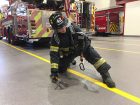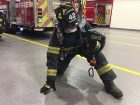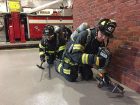
Timbits: A heads-up method for getting down low
Tim Llewellyn
Features Fire Ground Training annex firefighter trainingIn each edition of Tim-bits, I select a topic or technique that was introduced in recruit academies and became engrained as fire-service doctrine, then offer a field-tested and street-smart modification to make the practice easier, safer or more effective.
The tips I offer have typically been generated from one of two sources: the great instructors from whom I have had the opportunity to learn; and experiences I’ve had while responding to incidents and while teaching fire-service courses.
This month, I offer a variation of the crawling technique taught during basic firefighter education. In the hot and smoky hallways of the fire-academy burn tower, instructors encouraged us to stay low and crawl – typically on our hands and knees through the smoke, blindly feeling our way with our hands or an outstretched tool. There are two main reasons why firefighters are encouraged to crawl in a structure-fire environment:
- It’s cooler down low
- Visibility is often better nearer to the floor
It’s the crawling-on-hands-and-knees part of that basic education I would like to improve. Certainly, crawling on hands and knees offers a few positive points: we’ve been doing it since we were infants, so it requires no explanation; and, transitioning from standing or kneeling to crawling is relatively simple and efficient.
The improvement I’ve learned is a head-up, leg-out, or tripod position; the variation is slight, but our firefighters have found the benefits to be numerous. Instead of crawling on both hands and both knees, in this technique, one knee is down on the ground, the other knee is up with the foot outstretched, and one arm outstretched, hand down on the ground. Advancing entails reaching out with the down hand, stepping forward with the up knee, and dragging the down knee behind as the body moves forward to maintain the tripod position.
Crawling in this manner enables a firefighter’s head to be in a more upright position, but still keeps the upper part of the body low to the ground, out of the higher heat, and in a zone of better visibility. This position enables firefighters to experience the benefits of staying low that instructors beat into our heads but also allows firefighters to maintain a greater sense of awareness of their immediate surroundings. It’s quite possible that this heads-up position would allow a firefighter to see the faint wisps of rollover flame in the dark, which may have gone unnoticed if the firefighter were in a head-down, crawling position.
Another benefit is of the tripod method is that it frees one hand, which can be used to hold a tool or hose, or to direct and view a thermal imaging camera (TIC). While using a TIC, the traditional hands-and-knees crawling position requires the firefighter to stop moving, sit back, and then retrieve the TIC for effective viewing. The tripod crawling method allows the firefighter to hold the TIC upright in the free hand, and view the surroundings while moving, thus allowing a more efficient and potentially safer operation for that individual and team. Firefighters and students have also found that the tripod technique allows them to move faster than they do on their hands and knees.
As with any modification of a fire-service technique, it takes more than just reading an article to decide if the change will work for you or your department. I encourage you to gather a group of firefighters, put on gear, grab some tools and charge a line. Practise search techniques and run through a couple of hose-advancement drills with both the traditional crawling method and the tripod technique. Then, after you’ve weighed the pros and cons of each, use the method you like best and continue to train on it.
Now, head out to the training grounds and make sure you stay low!
Tim Llewellyn is a firefighter for the Allegheny County Airport Authority in Pittsburgh, Pa., and an instructor for a number of fire academies and training faculties.
llewellyn.fire@gmail.com
Print this page
Advertisement
- Ottawa department calls for investigation into allegations of misconduct
- Fire destroys multi-use bridge in Inkerman, N.B.


